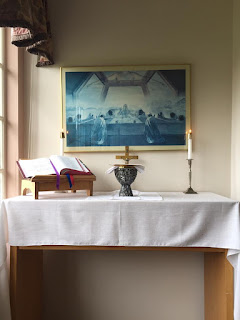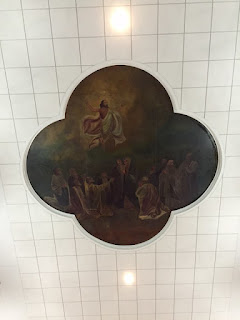As the pandemic appears to recede – although actually what is receding are our precautions, not the pandemic itself – one of the most seemingly self-evident precautions is being questioned. No, I am not referring to wearing a mask – the most obviously self-evident precaution of all – but to not drinking from the common chalice at Holy Communion. For some this abstention is straightforward. For others it is surprisingly fraught. Such differences may as much reflect how people perceived this far-from-universal practice even before 2020.
Twenty-three years ago, flying home for my father’s funeral, I packed my personal Mass chalice (photo) with me. It had been an ordination gift from my parents, and so I wanted to use it at the funeral Mass. Of course, it showed up on the security camera, and I took it out to show the agent. When she saw it she said, « Oh, I know what this is. Tell me, what is your opinion about Communion under both forms? » Surprise by the question, unexpected in such a setting, I simply said, « Some people favor it; some don’t; it’s a matter of choice in those places where it is allowed. » That satisfied the agent at the time. It satisfied me too, because I thought I had given a good answer that avoided all the ideological baggage that has come to be attached to this relatively rare practice.
But what was relatively rare historically and geographically became increasingly common in the United States since the 1970s. The first time I ever received from the chalice was at a students’ Mass at Princeton in the mid-1970s. From Princeton, I moved to Milwaukee. My first year there, the practice was introduced for general use in parishes. In seminary, of course, communion under both species (sub utraque specie, as we used to say in Catholic-speak) had become the norm, and it was increasingly becoming the norm in many of the parishes in which I subsequently served as a deacon and as priest – certainly not in all of them and certainly not all the time, but often enough as to acquire an aspect of normalcy.
All this was obviously a far cry from Vatican II’s rather limited and modest concession: « The dogmatic principles which were laid down by the Council of Trent remaining intact, communion under both kinds may be granted when the bishops think fit, not only to clerics and religious, but also to the laity, in cases to be determined by the Apostolic See, as, for instance, to the newly ordained in the Mass of their sacred ordination, to the newly professed in the Mass of their religious profession, and to the newly baptized in the Mass which follows their baptism » (Sacrosanctum Concilium, 55). As with so many such limited and modest concessions, the post-conciliar period saw a dramatic extension way beyond anything the Council Fathers had voted for. Even so, it seems safe to say that communion from the chalice, however common it may have become in many places in the US, has never become a widespread norm in most of the world
In the places where it had been implemented, however, it was often popular with many. Of course, as any Extraordinary Minister of Holy Communion could attest, many others passed by the chalice without drinking. No doubt their reasons were varied, but one constant concern has consistently been fear of infection. Just one month prior to the pandemic, we were instructed in the diocese where I was then a pastor to suspend communion from the chalice until the end of February because of a serious flu outbreak. We were permitted to resume the practice on March 1, 2020, but I delayed reintroducing it while waiting to see if that strange new virus which they were talking about on the news might impact us. Within weeks, we were literally closed, thanks to that strange new virus. For the next two months, most people would have to settle for « spiritual communion. » Since the reopening of the churches and the gradual loosening of other health precautions, my impression is that communion under one form only remains still the norm in most places, even those that had previously permitted communion from the chalice..
But some have argued for a resumption of the option of sharing the chalice, resulting in no small amount of understandable debate on line and elsewhere.
When people have become used to doing something, even when those who do it are actually a minority, they naturally miss it if deprived of it and want it back. So I can easily understand the sentiments of those who had become accustomed to receiving from the chalice prior to the pandemic, who now miss it, and who actively desire its return. I can also as easily appreciate the feelings of those for whom communion from the chalice is frightening or at least discomforting (for many of whom that was already the case, of course, even prior to the pandemic).
Perhaps one of the consequences of having attended Mass in the older rite for years growing up prior to the later liturgical revisions and then having lived through the many and various subsequent changes is that those many variations may come to appear just that – legitimate alternative ways of worshipping in this or that place, at this or that time, with no ultimately exclusive claim. Thus, if I were to attend Mass in a typical, present-day U.S. church, it would absolutely never occur to me to kneel down for communion. If circumstances suddenly changed, however, and I were directed to kneel at the altar rail as we all did until relatively recently in liturgical history, I would similarly have no problem doing so. (My aging knees might have a problem, but that is a different story altogether.)
Some have suggested that discomfort with drinking from the shared chalice is more an instinctive esthetic reaction rather than a rational scientific one. Maybe so. But it may well be that such intuitive esthetic emotional reactions may be one way we protect ourselves from danger. For some certainly, this is one example of that.
This seems to me to be the kind of case where such sensitivities may be more relevant (at least pastorally) than the ideological claims advanced by both sides of this discussion. Let it be stipulated that both sides make good arguments. In our polarized society, however, in which assertion is what matters and persuasion is no longer very valued by either side, maybe those arguments are just that – intellectual arguments that can convince no one not already on the relevant team.
So where do I come down now on this issue? I guess I am still more or less where I was on March 1, 2020, when re-institutionalizing the shared chalice was momentarily an optional decision. Absent an explicit command from higher authority, at present I think the practical sensitivities against resuming the practice probably outweigh whatever arguments there are for doing so. Some may sincerely miss drinking from the chalice, and I appreciate the sincerity of such sensitivities, but I suspect many more remain relieved that unnecessary health risks are not being multiplied right now.





